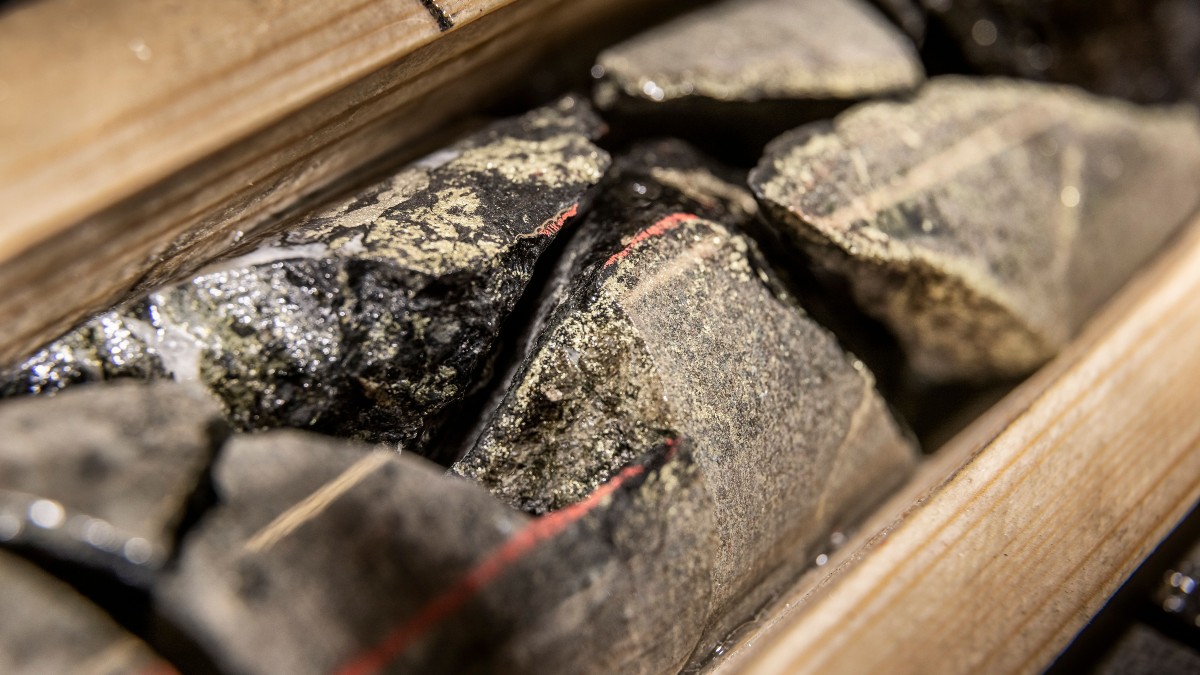Nyheter
David Hargreaves on Precious Metals, week 15 2014

We dwell in platinum this week, because unless the South African government takes a grip on its problems that metal will truly spotlight. See below. But platinum tracks gold, not vice-versa. This week gold put on 1.6% and is up 5.2% on the year to date. No big deal compared with its 24% 2013 fall eh? The drivers, which we stress to the point of boredom are, and will remain, the economic and military-political. The former is worth its 1-3% short term move and this week did not disappoint. We expect interest rates to rise, probably slowly, so that is a damper.
We expect the world economy to pick up, so that is another. Both good reasons for WIM to look at a $1200/oz base. The political military is out of our hands. Vladimir does not always answer the phone, so probably plotting his stealthy creep into the Ukraine. Both Egypt and India look like settling their elections peacefully and a knee-jerk towards $2000 plus does not look imminent. As for RSA, we increasingly care less, don’t we?
Palladium limped to its highest level since 2011, at $788/oz as the US threatened sanctions against Russia. Rum stuff this. The sister metal to platinum sells cheaper because it is not so efficient as a catalyst, but sort-of OK. So half price. It is more loved by diesel engines than petrol engines too. Here is how it stacks up:
Palladium Supply and Demand
- World Demand. c. 9,000,000 oz
- World Mined output. c. 6,500,000 oz
- Recycling and disinvestment. c. 2,500,000 oz
Major producers: Russia 44%, RSA 41%, North America 9%, other 6%. So Russia, thanks to its by product output from Norilsk Nickel, has a firmer foot print in the palladium market than it does in platinum. It also has had a major stockpile whose current status remains unknown. If the US decides to impose Ukrainian-related sanctions it could affect supplies. The major US producer Stillwater (SWC.N $15.52; Hi-Lo $16.03-9.80) produces about 6% of total world mined output.
Still on sanctions, Russia’s Polyus Gold may delist from the London market because of the threat of sanctions. A clutch of other companies could be affected including Uralkali, Polymetal, Highland Gold, PhosAgro. Petropavlovsk does not have a London listing.
South Africa’s platinum problems. The unions will lose this one. Platinum numbers favour the companies, not the unions. Are we missing a trick? Although it is a precious metal in all respects, it differentiates itself from Au in being largely an industrial one. About 50% is used in autocatalysts, which turn noxious exhaust fumes into harmless water vapour and nitrous oxides. Such a device lasts for about 50,000 running miles, but can then be recycled. So the numbers go like this:
- World demand for platinum in all forms: 7,700,000
- Investment demand 7% 550,000
- Autocatalyst demand 50% 3,850,000
- Recycling 900,000
- New production autocatalyst demand 2,950,000
- ETF Stockpiles: c. 2,000,000
- Industrial stockpiles annualised shortfall or zero production 500,000oz
- Weeks auto supply from stockpiles 44
Now you do not get a much better politico-economic fit than that which RSA has with platinum. But it is light years away from being able to exploit it because its industrial relations are a shambles matched only by its unattainable expansionary goals based on a deteriorating power supply. All this in election year.
The platinum industry problems began when a brand new workers’ union, AMCU, set up in opposition to the established NUM and demanded a doubling of wages. After 10 weeks of strikes the companies have offered 9% and adopted a take-it-or-leave-it attitude. Being South Africa this can turn bloody. The companies are at pains to assure their customers that they can meet their demands for the foreseeable future and on the above numbers would appear to have some justification.
Should it drag on, much will depend on the attitude of the exchange traded funds (ETFs) towards selling. The largest, RSA’s NewPlat ETF may have a dilemma but New York based Physical Platinum will suffer no such problems. Those two have over 1.5Moz which we suspect will come out at the right price. So industry looks ok for the next 44 weeks.
Not so the strikers and their families. There is little public sympathy for this strike but if the ANC government does not show its hand it will soon turn violent. President Zuma cannot surely endorse a doubling of wages can he? The man is well paid to be leader; now he must earn his keep.
Charity chapter two. A city colleague suggested, tongue-in-cheek this week, that following Rio Tinto’s lead, Amplats might donate its RSA operations to charity. The rationale, we think, was that they are rapidly becoming more trouble than they are worth. Let the locals see if they can make a go of where the London-tainted majors are failing. Well, hey presto, black-led Sibanye Gold has made a fist out of picking up high cost old gold mines on the Reef and is turning them to account. Now we hear it has made contact with Amplats about buying its high cost Rustenburg shafts. We will report more when we know more.
[hr]
About David Hargreaves
David Hargreaves is a mining engineer with over forty years of senior experience in the industry. After qualifying in coal mining he worked in the iron ore mines of Quebec and Northwest Ontario before diversifying into other bulk minerals including bauxite. He was Head of Research for stockbrokers James Capel in London from 1974 to 1977 and voted Mining Analyst of the year on three successive occasions.
Since forming his own metals broking and research company in 1977, he has successfully promoted and been a director of several public companies. He currently writes “The Week in Mining”, an incisive review of world mining events, for stockbrokers WH Ireland. David’s research pays particular attention to steel via the iron ore and coal supply industries. He is a Chartered Mining Engineer, Fellow of the Geological Society and the Institute of Mining, Minerals and Materials, and a Member of the Royal Institution. His textbook, “The World Index of Resources and Population” accurately predicted the exponential rise in demand for steel industry products.
Nyheter
Eurobattery Minerals förvärvar majoritet i spansk volframgruva

Eurobattery Minerals har tagit ett stort steg i sin utveckling genom att underteckna ett avtal om att förvärva en majoritetsandel i volframgruvan San Juan i Galicien, Spanien. Genom en investering på totalt 1,5 miljoner euro i det spanska bolaget Tungsten San Juan S.L. (TSJ), säkrar Eurobattery Minerals en ägarandel på 51 procent – och kontroll över projektet redan efter första delbetalningen.
Investeringen syftar till att bygga en pilotanläggning för mineralbearbetning och starta gruvdriften, som redan har alla nödvändiga licenser och ett preliminärt leveransavtal med Wolfram Bergbau und Hütten AG – en ledande volframproducent inom Sandvik-koncernen. Första leveranserna till Europa väntas ske under andra halvåret 2026, då även positivt kassaflöde förväntas genereras.
”Detta är en game-changer för oss. För första gången går vi från ett prospekteringsbolag till ett bolag med faktiskt intäktspotential inom en snar framtid,” säger VD Roberto García Martínez.
San Juan-projektet har bekräftade malmreserver på cirka 60 000 ton med en volframoxidhalt på 1,3 %. Volfram är en kritisk råvara med ökande strategisk betydelse för industri och försvar, och priset har stigit med över 40 % under 2025.
Med detta förvärv stärker Eurobattery Minerals både sin finansiella ställning och sin position som en europeisk leverantör av kritiska råmaterial – ett viktigt steg mot en hållbar och självförsörjande batterivärdekedja i Europa.
Nyheter
USA ska införa 50 procent tull på koppar

USA:s president Donald Trump har precis meddelat att landet ska införa en tull på 50 procent på basmetallen koppar. Priset på råvarubörsen i USA stiger omgående med 10 procent.
USA har viss inhemsk produktion av koppar, men den inhemska efterfrågan överstiger produktionen. Därför måste landet importera koppar för att täcka behovet, särskilt för användning inom elnät, elektronik, byggindustri och fordonssektorn. De största exportörerna till USA är Chile, Kanada, Mexiko och Peru.
När tullar av denna typ införs uppstår prisskillnader i världen. Handlar man koppar på börsen är det därför viktigt att veta vilken börs man handlar på eller om man använder certifikat så är det viktigt att veta vilka underliggande värdepapper de följer.
Sedan är det som alltid med Trump, begreppet är som bekant TACO, Trump Always Chickens Out. Man ska alltså inte ta några definitiva stora beslut baserat på vad han säger. Saker och ting kan ändra sig från dag till dag.
Nyheter
Ryska staten siktar på att konfiskera en av landets största guldproducenter

En våg av panik sprider sig bland Moskvas elit sedan Vladimir Putins regim inlett en dramatisk offensiv för att beslagta tillgångarna hos Konstantin Strukov – en av Rysslands rikaste affärsmän och ägare till landets största guldgruvföretag, Yuzhuralzoloto. Åtgärden ses som ett tydligt tecken på hur långt Kreml är villigt att gå för att säkra ekonomiska resurser i takt med att kostnaderna för kriget i Ukraina stiger.
Strukovs förmögenhet, som uppskattas till över 3,5 miljarder dollar, byggdes upp under decennier i nära relation med maktens centrum i Ryssland. Men den 5 juli stoppades hans privatjet från att lyfta mot Turkiet. Enligt flera ryska medier deltog den federala säkerhetstjänsten FSB i ingripandet, och Strukovs pass beslagtogs. Händelsen ska vara kopplad till en omfattande rättsprocess där åklagare kräver att hela hans företagsimperium förverkas – med hänvisning till påstådd korruption och användning av skalbolag och familjemedlemmar för att dölja tillgångar.
Företaget själva förnekar att något inträffat och kallar rapporteringen för desinformation. De hävdar att Strukov befann sig i Moskva hela tiden. Trots det bekräftar rättsdokument att både han och hans familj förbjudits att lämna landet, och att myndigheterna snabbt verkställt beslutet.
Det som nu sker är en del av ett större mönster i ett Ryssland präglat av krigsekonomi: staten tar tillbaka kontrollen över strategiska sektorer som guld, olja och försvarsindustri – industrier som nu allt mer mobiliseras för att finansiera och stödja krigsinsatsen. Intressant nog handlar det inte om att Strukov ska ha varit illojal mot regimen – tvärtom har han varit en lojal allierad, med politiska uppdrag knutna till Putins parti. Men lojalitet räcker inte längre som skydd.
Medan tidigare utrensningar ofta riktade sig mot krigskritiker eller de som flydde landet, drivs dagens tillgångsövertaganden av något mer fundamentalt: ekonomisk nöd. De växande sanktionerna har nästan helt strypt inflödet av utländskt kapital. Statens oljeintäkter minskar och budgetunderskotten växer. Putins lösning är att vända sig inåt – till de oligarker han själv lyfte fram – för att fylla statskassan.
Det här är inte ett enskilt fall. På senare tid har flera framstående affärspersoner hamnat i plötsliga rättsliga tvister, omkommit under mystiska omständigheter eller sett sina bolag tas över av staten. Den oskrivna överenskommelsen som länge gällde i Putins Ryssland – rikedom i utbyte mot lojalitet – håller på att kollapsa.
Den 8 juli väntar en rättsförhandling som kan avgöra framtiden för Strukovs affärsimperium. Men budskapet till Rysslands näringslivselit är redan tydligt: ingen är för rik, för lojal eller för nära den politiska makten för att gå säker. I ett Ryssland där kriget kräver allt större uppoffringar riskerar oligarker att snabbt förvandlas till måltavlor.
-

 Nyheter3 veckor sedan
Nyheter3 veckor sedanMahvie Minerals växlar spår – satsar fullt ut på guld
-

 Nyheter4 veckor sedan
Nyheter4 veckor sedanUppgången i oljepriset planade ut under helgen
-

 Nyheter4 veckor sedan
Nyheter4 veckor sedanLåga elpriser i sommar – men mellersta Sverige får en ökning
-

 Nyheter3 veckor sedan
Nyheter3 veckor sedanJonas Lindvall är tillbaka med ett nytt oljebolag, Perthro, som ska börsnoteras
-

 Analys3 veckor sedan
Analys3 veckor sedanA muted price reaction. Market looks relaxed, but it is still on edge waiting for what Iran will do
-

 Nyheter3 veckor sedan
Nyheter3 veckor sedanOljan, guldet och marknadens oroande tystnad
-

 Analys4 veckor sedan
Analys4 veckor sedanVery relaxed at USD 75/b. Risk barometer will likely fluctuate to higher levels with Brent into the 80ies or higher coming 2-3 weeks
-

 Nyheter3 veckor sedan
Nyheter3 veckor sedanDomstolen ger klartecken till Lappland Guldprospektering













